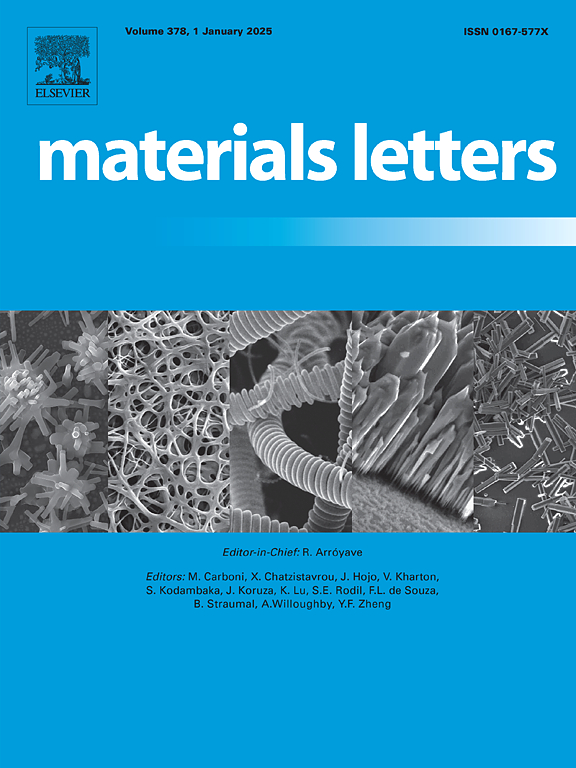Performance investigations of the easily manufactured composite all-day radiative cooling materials based on PDMS
IF 2.7
4区 材料科学
Q3 MATERIALS SCIENCE, MULTIDISCIPLINARY
引用次数: 0
Abstract
The passive radiative cooling technology can be employed to obtain the cooling capacity without any energy consumption, which has been garnering significant attention nowadays. This work proposes and experimentally studies the all-day radiative cooling material based on layered composite material made from Polydimethylsiloxane (PDMS). This work adds SiO2 nano-particles, which act as visible light scatters, and the proposed film can realize an excellent all-day cooling capacity when the thicknesses of the PDMS and Al films are respectively chosen as 200 μm and 4 μm, and the concentration of the SiO2 particles in the film is 40 %. The theoretical explorations indicated that the presented composite film can exhibit the high reflectivity (90.36 %) and emissivity (90.19 %) in the visible spectrum and atmospheric transparency window (ATW) spectrum. Under direct sunlight of a highest solar irradiance of 688.89 W/m2, there is an average temperature difference between cooling film and white paper of 6.3 °C. Furthermore, in clear weather conditions at night with an average humidity level of 58.15 %, it can generate a temperature difference of 4.8 °C. This work proposes an easily manufactured and eco-friendly all-day radiative cooling material, which has the potential applications in future refrigeration technology.
基于PDMS的易制式全天复合辐射冷却材料性能研究
采用被动辐射冷却技术可以在不消耗任何能源的情况下获得制冷量,目前已受到广泛关注。本文提出并实验研究了基于聚二甲基硅氧烷(PDMS)层状复合材料的全天辐射冷却材料。本研究添加了SiO2纳米粒子作为可见光散射体,当PDMS膜厚度为200 μm, Al膜厚度为4 μm,膜中SiO2浓度为40%时,所制备的薄膜具有优异的全天制冷性能。理论研究表明,所制备的复合薄膜在可见光光谱和大气透明窗(ATW)光谱上具有较高的反射率(90.36%)和发射率(90.19%)。在太阳直射下,最高太阳辐照度为688.89 W/m2,冷却膜与白纸的平均温差为6.3℃。此外,在夜间天气晴朗,平均湿度为58.15%的情况下,它可以产生4.8°C的温差。本工作提出了一种易于制造且环保的全天辐射冷却材料,在未来的制冷技术中具有潜在的应用前景。
本文章由计算机程序翻译,如有差异,请以英文原文为准。
求助全文
约1分钟内获得全文
求助全文
来源期刊

Materials Letters
工程技术-材料科学:综合
CiteScore
5.60
自引率
3.30%
发文量
1948
审稿时长
50 days
期刊介绍:
Materials Letters has an open access mirror journal Materials Letters: X, sharing the same aims and scope, editorial team, submission system and rigorous peer review.
Materials Letters is dedicated to publishing novel, cutting edge reports of broad interest to the materials community. The journal provides a forum for materials scientists and engineers, physicists, and chemists to rapidly communicate on the most important topics in the field of materials.
Contributions include, but are not limited to, a variety of topics such as:
• Materials - Metals and alloys, amorphous solids, ceramics, composites, polymers, semiconductors
• Applications - Structural, opto-electronic, magnetic, medical, MEMS, sensors, smart
• Characterization - Analytical, microscopy, scanning probes, nanoscopic, optical, electrical, magnetic, acoustic, spectroscopic, diffraction
• Novel Materials - Micro and nanostructures (nanowires, nanotubes, nanoparticles), nanocomposites, thin films, superlattices, quantum dots.
• Processing - Crystal growth, thin film processing, sol-gel processing, mechanical processing, assembly, nanocrystalline processing.
• Properties - Mechanical, magnetic, optical, electrical, ferroelectric, thermal, interfacial, transport, thermodynamic
• Synthesis - Quenching, solid state, solidification, solution synthesis, vapor deposition, high pressure, explosive
 求助内容:
求助内容: 应助结果提醒方式:
应助结果提醒方式:


